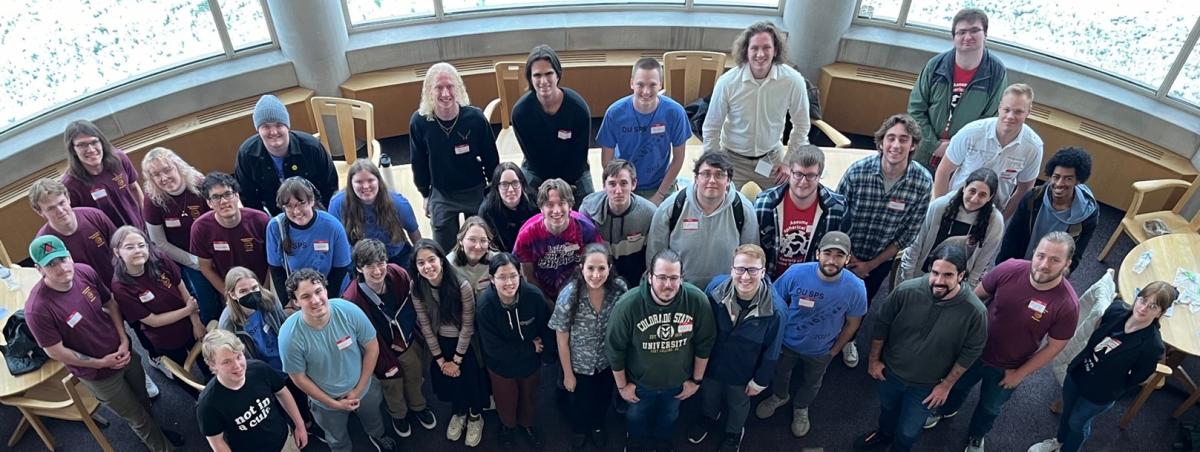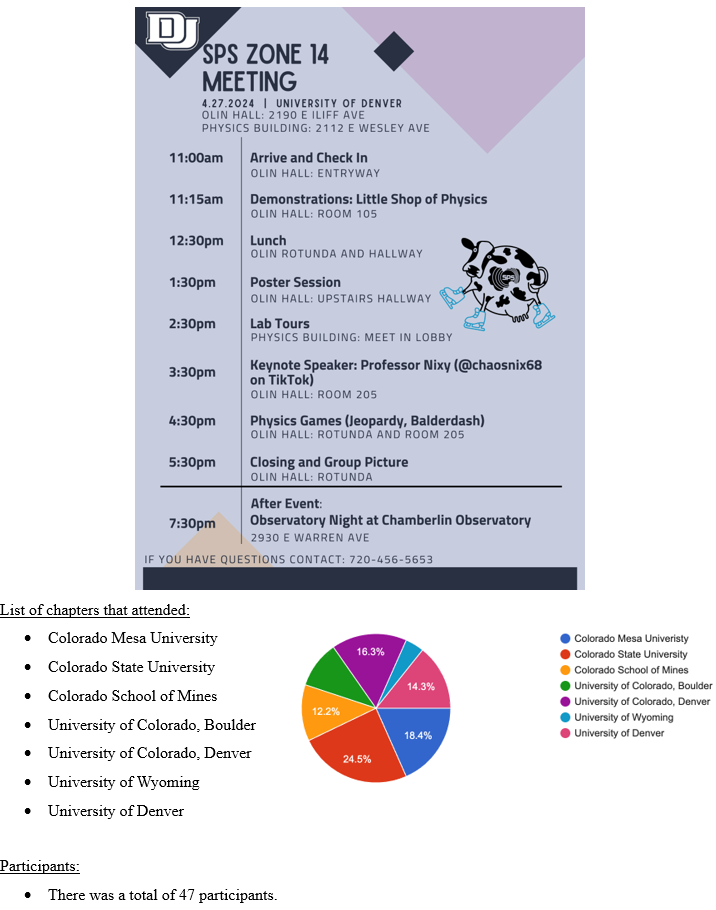SPS Zone Meeting
April 27, 2024
Denver, CO
Meeting host: By:Lark Bradsby
SPS Chapter:

Society of Physics Students Zone 14 Meeting Report 2024
Presented by the University of Denver

Narrative:
The Zone 14 Meeting of 2024 was a memorable event. When participants arrived, they checked in and had a few minutes to set up posters if they were presenting, then they started to meet other chapters. After this, participants were led to a lecture hall. A short introduction presentation was given. In this presentation the sponsors of the event were thanked, and every school got to cheer to represent themselves, giving each person an opportunity to learn where everyone is from. The associate zone councilors were given the stage to give a brief overview of what they are planning to do should they be given the position as well as information on themselves.
Then the real fun started. CSU’s Little Shop of Physics began their demonstrations by splitting people into groups and encouraging them to create a create a center of mass contraption using household objects such as binder clips, popsicle sticks, and pipe cleaners. Some groups took the approach of balancing two pipe cleaners on the ends of popsicle sticks and then putting the binder clips on either end. Other groups took the approach of making a front heavy contraption by connecting two popsicle sticks in a cross pattern and adding binder clips to the front. Groups then were able to present and share their creations. Then the activity transitioned into creating robots that could draw. The materials that groups were given included a cup, markers, tape, pipe cleans, a motor, battery pack and clothes pins. Groups then started to work together to try to make the best robot to draw. Many groups struggled with this task at first and were unsure how to make this motor that was not super powerful draw with these markers. But through perseverance and teamwork most groups figured out something that worked. The most successful approach was having the motor turn the clothespin on the top of a cup with markers attached to have the distribution of mass be uneven as the motor spins around so the markers would drag and move around. Then there was a short presentation of the different robots and the masterpieces they created.
There was a short transition to lunch. There was pizza, chips, soda, and salad available. Due to the snow, we ate in the rotunda. At lunch, chapters had the opportunity to meet one another and learn about what is going on at other chapters. Then once everyone was fueled for the rest of the day, we began the poster session.
At the poster session, students were given the opportunity to speak about their research and other participants learned about research that was going on at other schools. There were 15+ projects on topics including water quality and oxygenation of ponds, medical physics cancer treatment protocols, atomic clocks, and so much more.
Next, we transitioned to lab tours. We had the chance to look at three different labs for 15 minutes each on the DU campus. In the Siemens lab there are many projects happening, including those on phase shifting holography, optical vortices and even a new way to image bodily tissues. Professor Siemens showed us a typical optical setup that is used to gather data, as well as a few diffraction gratings with different animals on them to show us how the optical set up was working. He also talked through some of the science behind these optical vortices and the practical applications of them, such as entanglement and communication.
For Dr. Xin Fan's portion of the lab tours, he walked the group through the entirety of his lab, from fabricating samples to actually running experiments. To begin, he showed the deposition chamber where his group fabricates samples and explained how the sputtering process works. Then, he explained the photolithography process and how they use different masks and UV light to pattern the samples made in-house. After that, he brought the group around to where various experiments were being run and quickly gave background on each of them, for example, his projects on FerroMagnetic Resonance and the Magneto-Optical Kerr Effect.
Dr. Barry Zink split his tour time between himself and one of his recently graduated graduate students. Dr. Zink himself talked about the work he does in experimental condensed matter physics, specifically the study of order and disorder in small structures through thermal, electronic, thermoelectric, and spin transport interactions in these structures. He also showed us the liquid helium recycling system in place that his team uses to cool apparatus and minimize waste. The second part of the tour was led by his student, Dr. Sam Bleser, who showed the group the Scanning Electron Microscope the team uses to fabricate samples using Electron-beam Nanolithography.
Then we went to the keynote speech given by Professor Nixy who has quite a large TikTok following (750K) and has hosted the most viewed TikTok livestream. In his speech he detailed his experience dealing with science misinformation online, as well as how people have a strong desire for information and social media can make science accessible to a larger community. He also passed around some really cool lunar rocks and meteorites. He shared some examples of demos that he would share online during his TikTok livestreams. These demos include a super conductor made with magnets and liquid nitrogen, and a Tesla Coil with tubes of different gases, which were excited and emitted different color light when brought near the Tesla Coil. He talked about how rewarding it is to make science accessible to others and encourage others to continue to pursue a degree. He encouraged people to interact with the demos hands-on.
Next the group split into two different groups based on interest. A group of participants went to play physics Balderdash while another group played physics Jeopardy, both groups were provided snacks. The group who played Balderdash was split into two smaller groups and given a rule sheet, a stack of cards with obscure physics terms with definitions on the back, and definition cards. Groups then got to playing. The dasher would draw three obscure physics cards and chose their favorite. They read out the physics term and then everyone but the dasher made up a definition. The dasher writes down the definition on the back of the card. Then the dasher collects all the definition cards and reads them out. The definitions are then voted on based on what participants think the correct answer is. The zone meeting participants had a lot of fun with this game. One group made it their mission to trick others and used a lot of fancy physics jargon to throw other players off. The other group took a more fun approach by writing down hilarious definitions that did not make sense. There was a ton of laughter and connections made throughout the entire game.
For the other group, DU SPS officers ran Jeopardy using a PowerPoint from SPS National's website. Everyone split into teams of 2-4 people, so the teams had the opportunity to work together and discuss their answers. It was relaxed and low-stakes, but still a lot of fun for everyone involved, including the DU SPS officers, who got to practice their improvisational comedic performance routine.
Then we wrapped up the day with a few words of gratitude, announcements and a group picture. Then some groups went together to grab some food before the after event at Chamberlin Observatory.
Finally, we went to the after-event at historic Chamberlin Observatory. During this event small groups had the chance to look at the powerful telescope housed in the observatory. They learned about the rich history of the observatory and how the telescope is operated even today.
Recommendations for future Zone Meetings:
Hosting the SPS Zone Meeting as the University of Denver's SPS Chapter President was an immensely rewarding and valuable experience. I not only gained a deeper understanding of the details of organizing a conference but also had the opportunity to develop stronger connections with our Physics department.
Drawing from my experience, I would like to propose a few recommendations specifically tailored to SPS National. To begin with, I believe that allowing chapters to volunteer for hosting zone meetings, rather than assigning the task would be beneficial for chapters excited about hosting the Zone Meeting and who have adequate resources to do so. Additionally, it would simplify logistics if the visiting chapters could handle their housing arrangements, which could be funded by the overall budget but remain under the visiting chapters supervision. Lastly, enhancing communication regarding the financial disbursements, specifically, who the check is made out to (for example the SPS chapter versus the advisor). This might be best to coordinate with the SPS chapter advisor as well as the students in the chapter.
For other chapters hosting Zone meetings, I would recommend getting as many people as makes sense involved in planning. Things became much easier for me when I talked to the departmental administrative assistant and reached out to professors. I also think that having a dedicated time to meet the few weeks leading up to the meeting was very helpful to iron out the last few details.






